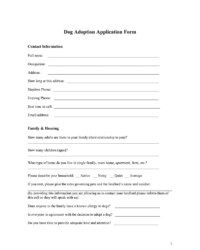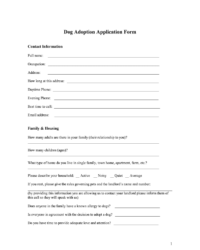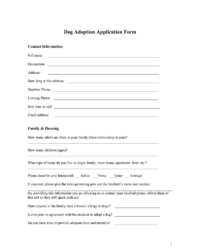Utilizing such forms streamlines the adoption process, allowing organizations to efficiently collect consistent data. This facilitates informed decision-making, ultimately increasing the likelihood of positive outcomes for both the animals and their adopters. It also provides a professional and organized experience for individuals interested in providing a loving home.
This article will explore the key components of these valuable resources and offer guidance on their effective use within the pet adoption process.
Key Components of a Pet Adoption Application
Effective applications collect comprehensive information to assess suitability of potential adopters. Several key components ensure thorough evaluation.
1: Personal Information: Full name, address, phone number, and email address are fundamental for contact and identification.
2: Household Information: Details about the home environment, such as whether it is a house or apartment, owned or rented, are relevant. Information regarding other household members (adults, children, and other pets) contributes to understanding the prospective home environment.
3: Lifestyle: Questions regarding work schedules, activity levels, and travel frequency help determine the applicant’s ability to provide consistent care.
4: Pet History: Previous pet ownership experience, including details about past pets (type, age, reason for rehoming), provides insights into the applicant’s experience and commitment.
5: Veterinary References: Contact information for previous or current veterinarians allows organizations to verify pet care history and responsible pet ownership practices.
6: Landlord Contact (if applicable): If renting, landlord contact information allows verification of pet policies and ensures compliance.
7: Adoption Preferences: Information on preferred animal age, breed, size, and activity level helps match applicants with suitable companions.
8: Agreement and Signature: Formal agreement to the terms and conditions of adoption finalizes the application process.
Gathering this detailed information ensures careful consideration of each application, promoting successful and lasting adoptions.
How to Create a Pet Adoption Application Template
Creating a comprehensive application template is crucial for animal shelters and rescue organizations. A well-structured template ensures the collection of essential information for informed adoption decisions. The following steps outline the process of developing an effective template.
1: Define Objectives: Clearly outline the goals of the application process. Determining the specific information needed to assess potential adopters is essential.
2: Structure the Template: Organize the template logically into sections. Clear headings and subheadings improve readability and ensure all necessary information is gathered.
3: Include Essential Fields: Incorporate fields for personal information, household details, lifestyle, pet history, veterinary references, landlord contact (if applicable), and adoption preferences. A signature line for agreement to terms and conditions is also necessary.
4: Formulate Clear Questions: Use concise and unambiguous language. Avoid jargon or technical terms. Questions should be easy to understand and answer.
5: Consider Accessibility: Ensure the template is accessible to individuals with varying literacy levels and language proficiency. Offer multiple formats, if possible.
6: Test and Refine: Pilot test the application with a small group to identify any areas for improvement. Gather feedback and revise the template accordingly.
7: Implement and Train: Distribute the finalized template to staff and volunteers. Provide training on its proper use and the importance of consistent data collection.
A thoughtfully constructed application template, consistently utilized, promotes successful adoptions by facilitating informed decision-making and ensuring the well-being of animals in need of loving homes.
Standardized forms for pet adoption serve as crucial instruments for responsible rehoming practices. These structured applications enable organizations to gather essential information, facilitating informed decisions that prioritize animal welfare and successful placements. By collecting comprehensive data regarding lifestyle, pet history, and household dynamics, organizations can effectively evaluate the suitability of potential homes. A well-designed template ensures consistency in the evaluation process, promoting fairness and transparency.
Effective implementation of these vital resources significantly contributes to reducing pet relinquishment rates and enhancing the lives of animals entrusted to shelters and rescue organizations. Continued refinement and adaptation of application processes, based on ongoing evaluation and best practices, remain essential for strengthening the adoption process and ensuring positive outcomes for both animals and adopters.


